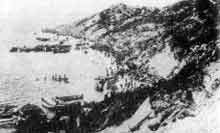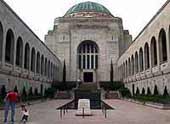ANZAC DAY
What is ANZAC Day?
ANZAC Day – 25 April – is probably Australia's most important national occasion. It marks the anniversary of the first major military action fought by Australian and New Zealand forces during the First World War.
What does ANZAC stand for?
ANZAC stands for Australian and New Zealand Army Corps. The soldiers in those forces quickly became known as ANZACs, and the pride they took in that name endures to this day.

Ari Burnu (ANZAC Cove), showing the landing boats. Image courtesy of the Department of Veterans Affairs.
Why is this day special to Australians?
When war broke out in 1914, Australia had been a country for only 13 years. The new national government was eager to establish its reputation among the nations of the world. In 1915 Australian and New Zealand soldiers formed part of the allied expedition that set out to capture the Gallipoli peninsula in order to open the Dardanelles to the allied navies. The ultimate objective was to capture Constantinople (now Istanbul in Turkey), the capital of the Ottoman Empire, an ally of Germany.
The Australian and New Zealand forces landed on Gallipoli at dawn on 25 April, meeting fierce resistance from the Ottoman Turkish defenders. What had been planned as a bold stroke to knock Turkey out of the war quickly became a stalemate, and the campaign dragged on for eight months. At the end of 1915 the allied forces were evacuated, after both sides had suffered heavy casualties and endured great hardships. Over 8,000 Australian soldiers had been killed. News of the landing on Gallipoli had made a profound impact on Australians at home, and 25 April soon became the day on which Australians remembered the sacrifice of those who had died in the war.
Although the Gallipoli campaign failed in its military objectives, the Australian and New Zealand actions during the campaign left us all a powerful legacy. The creation of what became known as the “ANZAC legend” became an important part of the identity of both nations, shaping the ways they viewed both their past and their future.
The ANZAC Legend
The landing at Gallipoli was seen as a story of courage and endurance amongst death and despair, in the face of poor leadership from London, and unsuccessful strategies. War correspondents, such as Charles Bean, hailed the Australians for their dash in attack and doggedness in defence and the ANZAC legend was born.
“It is a legend not of sweeping military victories so much as triumphs against the odds, of courage and ingenuity in adversity. It is a legend of free and independent spirits whose discipline derived less from military formalities and customs than from the bonds of mateship and the demands of necessity.”
Former Prime Minister of Australia, the Hon Mr Paul Keating, at the Entombment of the Unknown Soldier at the Australian War Memorial, 1993

Commemorative Area at the Australian War Memorial. Image courtesy of the Australian War Memorial
ANZAC DAY and Turkey
A unique aspect of ANZAC Day is how it has helped form lasting bonds of friendship between Australia and its former enemy, Turkey. Every year, Turkey hosts an ANZAC Day service near the shores of Gallipoli. The Gallipoli campaign is an important part of Turkish history. Despite the huge loss of life on both sides, both countries commemorate the sacrifices of their respective soldiers. This is best epitomised in The ANZAC Memorial, the tribute written in 1934 to the memory of the ANZACs by M. Kemal Atatürk, the founder of the Turkish Republic.
The ANZAC Memorial
Those heroes that shed their blood And lost their lives...
You are now lying in the soil of a friendly country.
Therefore, rest in peace.
There is no difference between the Johnnies
And the Mehmets to us where they lie side by side,
Here in this country of ours.
You, the mothers, who sent their sons from far away countries...
Wipe away your tears.
Your sons are now lying in our bosom And are in peace.
After having lost their lives on this land, they have
Become our sons as well.
M. Kemal Atatürk
1934
Ode to Remembrance
The Ode to Remembrance is said at each ANZAC Day service. It is the fourth stanza of the poem “For the Fallen” by Laurence Binyon, first published in 1914. At the end of the final line, it is common for the audience to respond “We Will Remember Them.”
They shall grow not old, as we that are left grow old:
Age shall not weary them, nor the years condemn.
At the going down of the sun and in the morning,
We will remember them.
Laurence Binyon
1914
More information
Australian Government ANZAC Day site
Australian War Memorial
Department of Veterans Affairs
